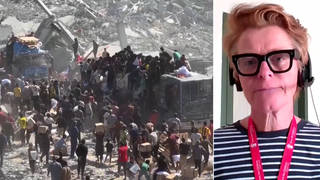
Topics
Guests
- Moazzam Beggformer Guantánamo detainee now living in London. He was held in extrajudicial detention by the U.S. government from 2002 to 2005, first in Kandahar, then at Bagram Air Base for approximately a year before being transferred to Guantánamo. His book is titled Enemy Combatant: My Imprisonment at Guantánamo, Bagram, and Kandahar. He is now outreach director at the London-based organization CAGE, which advocates on behalf of victims of the “war on terror.”
As President Trump continues to refuse to close the U.S. military prison at Guantánamo, we speak to a former prisoner at the camp—Moazzam Begg. He was held in extrajudicial detention by the U.S. government from 2002 to 2005, first in Kandahar, then at Bagram Air Base, for approximately a year before being transferred to Guantánamo.
Transcript
AMY GOODMAN: Moazzam Begg, as we wrap up, I want to ask you about the U.S. military prison at Guantánamo, where you were held. Guantanamo, opened by President George W. Bush when the U.S. launched it’s so-called war on terror, President Obama pledged to close it as one of his first acts after taking office in 2009, but Republicans repeatedly blocked his efforts. This is President Trump speaking in his first State of the Union address in January.
PRESIDENT DONALD TRUMP: I just signed, prior to walking in, an order directing Secretary Mattis, who is doing a great job—thank you—to re-examine our military detention policy and to keep open the detention facilities in Guantánamo Bay. I am asking Congress to ensure that in the fight against ISIS and al-Qaeda, we continue to have all necessary power to detain terrorists wherever we chase them down, wherever we find them. And in many cases, for them, it will now be Guantánamo Bay.
AMY GOODMAN: Moazzam Begg, as we wrap up and you listen to President Trump, scores of prisoners are still held at Guantánamo. You were released in 2005. The significance of Guantánamo, not only just what it’s doing to the prisoners there now, but what it means as a symbol around the world?
MOAZZAM BEGG: I think if you remember recently, there were a couple of ISIS prisoners captured, two British guys, apparently, who are in now the custody of the Syrian defense forces. And these two individuals are accused of being involved in the execution of others, including American citizens, people like James Foley, who was a journalist documenting the oppression against the Syrian people. And what they’re accused of having done to him is beheading him, whilst dressing him in an orange jumpsuit.
But what perhaps people don’t know, what they did to him before that and to others, was they waterboarded him. Now, it’s really important that we understand this, because the president of the United States of America has said openly that he will waterboard, and he would do a lot more than that. He believes torture works. And he will, as he has said, keep Guantánamo open, and he has signed an order to that effect.
So, let’s just go back—backtrack a little bit. The U.S. invaded Iraq as a result of the torture of a man called Ibn al-Shaykh al-Libi, who gave a false confession that he, al-Qaeda, his organization, were working with Saddam on obtaining weapons of mass destruction. That was used as a justification to invade Iraq. Al-Qaeda didn’t exist in Iraq until the invasion. And they came in, of course. There were no weapons of mass destruction. The U.S. military then set up prisons like Camp Abu Ghraib and Camp Bucca, where they essentially Guantánamo-ized the prison system.
So, you had General Geoffrey Miller, who I met personally, who was responsible for my detention when I was held in Guantánamo, and then he went on to practice the techniques that he had perfected in Guantánamo on Abu Ghraib. In Abu Ghraib and in Camp Bucca, you had 17 of the leaders who later became ISIS leaders, of the 25 leaders, all graduate through the prisons of America. And lo and behold, they come out and started to practice the same torture techniques that were practiced upon them. So ISIS was born in the prisons of the United States of America that resulted from the torture that Donald Trump now says works and that he believes in. And his testimony, living testimony, to that is that, to great applause, he says that he will keep that facility open.
Well, Guantánamo has only destroyed whatever little reputation the United States had in terms of human rights in the rest of the world. There were countries chiding the United States of America, from developing countries in Africa and elsewhere, saying, “What right does the United States have to talk to us about detention without trial, when it has Guantánamo sitting at its doorstep near Miami?” So, at least with Obama—with Trump, you’ve got somebody who says what he believes in. Prior to this, you had the Bush administration who said—who wouldn’t even call it torture. They’d say it’s enhanced interrogation techniques. They’d get their lawyers to redraft its entire meaning.
The Obama administration said, “We won’t torture anymore. We’ll stop torture.” But he ensured that anybody who was involved in the torture wouldn’t be prosecuted, and that’s why now, today, you have a president who feels that it’s fine to endorse war crimes, because he knows there is no precedent for a prosecution for saying this. So, whichever administration, I think torture is as American as apple pie.
AMY GOODMAN: Well, we’re going to leave it there. I want to thank you for being with us, Moazzam Begg, ex-Guantánamo prisoner, speaking to us from London, now outreach director at CAGE, released from Guantánamo in 2005, tortured by the U.S. military in Bagram in Afghanistan, and before that was brought to Kandahar. I also want to thank Professor Rashid Khalidi, the Edward Said professor of Arab studies at Columbia University. This is Democracy Now! Stay with us.












Media Options